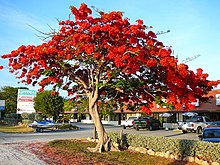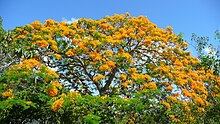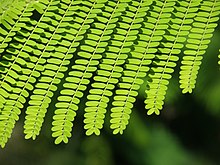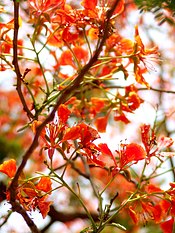Delonix regia
| Delonix regia | |
|---|---|

| |
| Tree in full bloom in the Florida Keys | |
| Scientific classification | |
| Kingdom: | |
| (unranked): | |
| (unranked): | |
| (unranked): | |
| Order: | |
| Family: | |
| Subfamily: | |
| Genus: | |
| Species: | D. regia
|
| Binomial name | |
| Delonix regia | |
Delonix regia is a species of flowering plant in the family Fabaceae, subfamily Caesalpinioideae. It is noted for its fern-like leaves and flamboyant display of flowers. In many tropical parts of the world it is grown as an ornamental tree and in English it is given the name Royal Poinciana or Flamboyant. It is also one of several trees known as Flame tree.
In India it is known as Gulmohar (Hindi and Urdu -‘Gul’ means ‘Flower’ and ‘Mohr’ is 'coin'. It is also known there as Krishnachura (Bengali: 'crown of the Lord Krishna). In Vietnamese it is known as Phượng vĩ (means "Phoenix's Tail) (Vietnamese), Malinche, and Tabachine.[1] In Guatemala, Antigua Guatemala, it is known as "Llama del Bosque".
This species was previously placed in the genus Poinciana, named for Phillippe de Longvilliers de Poincy, the 17th century governor of Saint Christophe (Saint Kitts), who is credited with introducing the plant to the Americas. Because it is a legume, the tree has nitrogen-fixating and soil-improving properties.
Description
The tree's vivid red/vermilion/orange/yellow flowers and bright green foliage make it an exceptionally striking sight.



The Royal Poinciana is found in Madagascar's Madagascar dry deciduous forests. In the wild it is endangered, but it is widely cultivated elsewhere. In addition to its ornamental value, it is also a useful shade tree in tropical conditions, because it usually grows to a modest height but spreads widely, and its dense foliage provides full shade. In areas with a marked dry season, it sheds its leaves during the drought, but in other areas it is virtually evergreen.

The flowers are large, with four spreading scarlet or orange-red petals up to 8 cm long, and a fifth upright petal called the standard, which is slightly larger and spotted with yellow and white. The naturally occurring variety flavida has yellow flowers.[2] Seed pods are dark brown and can be up to 60 cm long and 5 cm wide; the individual seeds, however, are small, weighing around 0.4 g on average. The compound leaves have a feathery appearance and are a characteristic light, bright green. They are doubly pinnate: Each leaf is 30–50 cm long and has 20 to 40 pairs of primary leaflets or pinnae on it, and each of these is further divided into 10-20 pairs of secondary leaflets or pinnules.
Environmental requirements
The Royal Poinciana requires a tropical or near-tropical climate, but can tolerate drought and salty conditions. It is very widely grown in the Caribbean, Africa, Northern Australia (as far south as South east Queensland, although in sheltered micro climates it can be successfully grown in some areas of Sydney), Hong Kong, the Canary Islands, Cyprus, Thailand, Taiwan and southern China, and is also the city tree of Tainan, Taiwan and Xiamen, Fujian Province, People's Republic of China. National Cheng Kung University, a university located in Tainan, put Royal Poinciana on its emblem. It also grows throughout southern Brazil, with ornamental trees in Rio Grande do Sul (Canoas and Porto Alegre).[3]
Geographical growth range
Delonix regia is endemic to the western forests of Madagascar, but has been introduced into tropical and sub-tropical regions worldwide. In the continental United States, it grows in South Florida, Southwest Florida, the Rio Grande Valley of South Texas, ranging from the low deserts of Southern Arizona (to as high as Tucson), and Southern California. It also grows in Hawaii, Puerto Rico, U.S. Virgin Islands, Guam and the Commonwealth of the Northern Mariana Islands, where it is the official tree of the islands. It is much loved in the Caribbean; for example, many Puerto Rican paintings feature Flamboyant Trees, it can also be found in The Bahamas as well. The Poinciana is also the national flower of St. Kitts and Nevis.
The Royal Poinciana is regarded as naturalised in many of the locations where it is grown. It is a popular street tree in the suburbs of Brisbane, Australia. The tree is also found in India and Pakistan, where it is referred to as the Gulmohar, or Gul Mohr.[4] In West Bengal (India) and Bangladesh it is called Krishnachura.
The town of Peñuelas, Puerto Rico, located about 12 miles west of Ponce, is nicknamed "El Valle de los Flamboyanes" ("The Valley of the Poinciana Trees"), as many Flamboyant trees are found along the surrounding Río Guyanes, Río Macana, and Río Tallaboa Rivers.
In Vietnam, this tree is called "Phượng vỹ", or phoenix's tail, and is a popular urban tree in much of Vietnam. Its flowering season is May - July, which coincides with the end of the school year in Vietnam. Because of this timing, the flower of Poinciana is sometimes called the "flower of pupil". Hai Phong city is nicknamed "Thành phố hoa phượng đỏ" ("City of red Poinciana").
Flowering season


- South Florida: May–June
- Vietnam: May–July
- Caribbean: May–September
- India, Pakistan, Bangladesh: April–June
- Australia: December–February
- Northern Mariana Islands: March–June
- United Arab
- Brazil: November–February
- Southern Sudan: March–May
- Thailand: April–May
- Zimbabwe: October–December
- Hong Kong: May-June
References
- ^ Presentación de PowerPoint
- ^ a b Don Burke (1 November 2005). The complete Burke's backyard: the ultimate book of fact sheets. Murdoch Books. p. 269. ISBN 978-1-74045-739-2. Retrieved 9 March 2011.
- ^ [1]
- ^ Cowen, D. V. (1984). Flowering Trees and Shrubs in India, Sixth Edition. Bombay: THACKER and Co. Ltd. p. 1.
- Template:IUCN2006 Listed as Vulnerable (VU B1+2c v2.3)
- Floridata data base
- ARKive - images and movies of the flame tree (Delonix regia)

